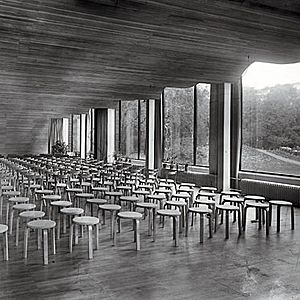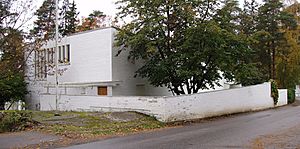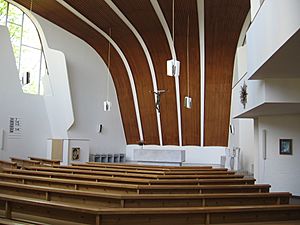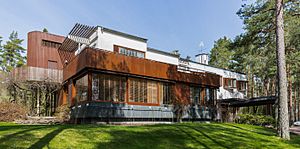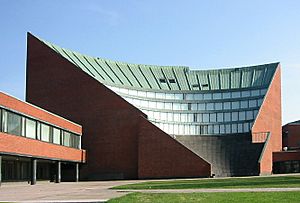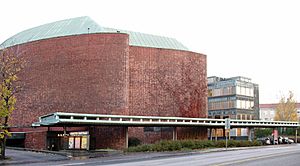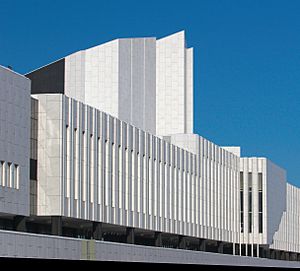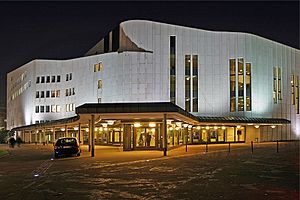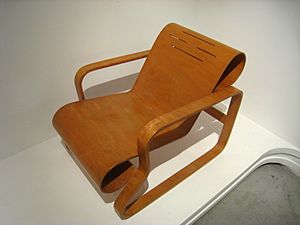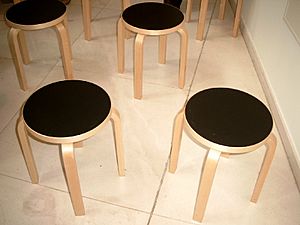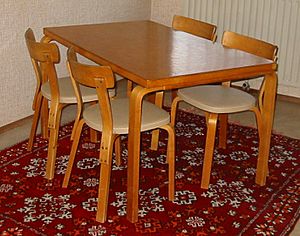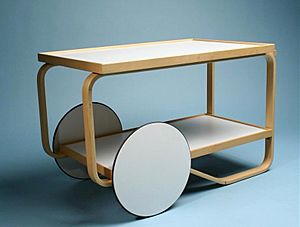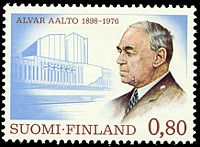Alvar Aalto facts for kids
Quick facts for kids
Alvar Aalto
|
|
|---|---|
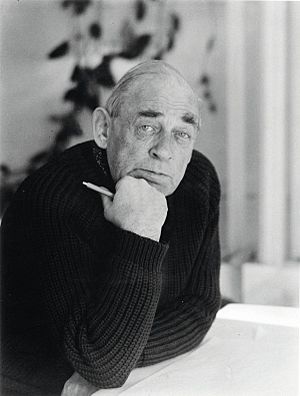
Aalto in 1960
|
|
| Born |
Hugo Alvar Henrik Aalto
3 February 1898 Kuortane, Grand Duchy of Finland, Russian Empire
|
| Died | 11 May 1976 (aged 78) Helsinki, Finland
|
| Nationality | Finnish |
| Alma mater | Helsinki University of Technology |
| Occupation | Architect |
| Spouse(s) | |
| Children | 2 |
| Awards | Prince Eugen Medal (1954) RIBA Gold Medal (1957) AIA Gold Medal (1963) |
| Buildings | Paimio Sanatorium Säynätsalo Town Hall Viipuri Library Villa Mairea Baker House Finlandia Hall |
| Projects | Helsinki City Centre |
| Design | Savoy Vase Paimio Chair |
| Signature | |
 |
|
Hugo Alvar Henrik Aalto (born February 3, 1898 – died May 11, 1976) was a famous Finnish architect and designer. He created buildings, furniture, textiles, and glassware. He also made sculptures and paintings. Aalto believed that painting and sculpture were like "branches of the tree whose trunk is architecture."
Alvar Aalto's career happened during a time when Finland was growing fast. Many of his clients were business owners who supported his work. His designs changed over time, from an early classical style to a more modern and natural style.
Aalto saw his designs as a total work of art (Gesamtkunstwerk). With his first wife, Aino Aalto, he designed not just the building but also the inside, including furniture, lamps, and glassware. His furniture designs are known as Scandinavian Modern. They are simple, elegant, and often use wood. Aalto even got patents for new ways to bend wood. He was a pioneer of mid-century modern design. His bent plywood furniture influenced designers like Charles and Ray Eames. The Alvar Aalto Museum in Jyväskylä was designed by Aalto himself.
Contents
Alvar Aalto's Life Story
Early Life and Education
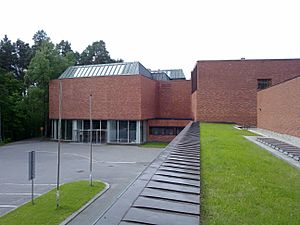
Hugo Alvar Henrik Aalto was born in Kuortane, Finland. His father was a land-surveyor, and his mother was a postmistress. When Alvar was five, his family moved to Alajärvi, and then to Jyväskylä.
He went to school in Jyväskylä and took drawing lessons. In 1916, he started studying architecture at the Helsinki University of Technology. His studies were paused when he fought in the Finnish Civil War. He fought for the White Army.
While still a student, he designed his first building: a house for his parents in Alajärvi. He graduated in 1921. In 1922, he did his military service.
Starting His Career
In 1920, Aalto traveled abroad for the first time, visiting Sweden. In 1922, he completed his first independent design project in Tampere. In 1923, he opened his own architecture office in Jyväskylä. He also wrote articles for a local newspaper. During this time, he designed many small houses.
On October 6, 1924, Aalto married architect Aino Marsio. They went to Italy for their honeymoon. This trip made them both love the culture of the Mediterranean region.
They worked on several projects together, including the Jyväskylä Worker's Club. In 1927, they won a competition and moved their office to Turku. They worked with another architect, Erik Bryggman. In 1933, they moved their office again to Helsinki.
The Aaltos designed a house and office for themselves in Helsinki in 1935–36. Later, they built a separate office building (1954–56). Their first house is now a museum. In 1926, they also designed a summer cottage called Villa Flora.
Alvar and Aino had two children: a daughter, Johanna (born 1925), and a son, Hamilkar (born 1928). Aino Aalto passed away in 1949.
In 1952, Aalto married another architect, Elissa Mäkiniemi. He designed a summer cottage for them, called the Experimental House, in Muuratsalo. Alvar Aalto died on May 11, 1976, in Helsinki. He is buried in the Hietaniemi cemetery. Elissa Aalto continued to run his office until 1994.
Alvar Aalto's Architecture Career
Early Designs: Nordic Classicism


Alvar Aalto is known as a pioneer of Nordic Classicism and modernism in Finland. He was influenced by other architects in Sweden. Many architects of his time in Nordic countries had a classical education. This style was a reaction to the earlier National Romantic style.
When Aalto opened his office in Jyväskylä in 1923, he designed several homes in the Nordic Classicism style. He also completed his first public buildings, like the Jyväskylä Workers' Club (1925). He entered many design competitions for important public buildings.
Aalto's first church design, Muurame church, shows his change from Nordic Classicism to Functionalism. During this period, Aalto wrote many articles for journals and newspapers.
Moving to Functionalism
Aalto's design style changed from classicism to modernism with the Viipuri Library in Vyborg (1927–35). This building started as a classical design but became a modern one. In the library, Aalto used natural materials, warm colors, and wavy lines.
Because of money issues, the Viipuri Library project took eight years. During this time, Aalto designed other important buildings. These included the Turun Sanomat Building (1929–30) and the Paimio Sanatorium (1929–32). He worked on the sanatorium with his first wife, Aino Aalto.
These early modern buildings showed Aalto's unique style. He started to question strict modernism and added more natural, organic shapes. He became a member of an international architecture group called CIAM. He also became good friends with other famous modern architects.
Aalto gained worldwide attention after the Paimio Sanatorium (1932) and Viipuri Library (1935) were finished. His fame grew in the US after an exhibition of his work in New York in 1938. He was only the second architect to have a solo exhibition at the museum. His design for the Finnish Pavilion at the 1939 New York World's Fair was called a "work of genius" by Frank Lloyd Wright.
Experimenting with Designs
In the 1930s, Alvar Aalto experimented with laminated wood, sculptures, and abstract art. He used this knowledge to solve problems with how flexible wood could be. This helped him create new shapes in his designs.
Aalto's experiments with wood were seen in the Villa Mairea (1939) in Noormarkku. This was a luxury home for a wealthy couple, Harry and Maire Gullichsen. Maire Gullichsen worked closely with Alvar and Aino Aalto. She encouraged them to be bold with their designs. The house has a U-shape around a central garden with a kidney-shaped swimming pool. The design mixes traditional Finnish styles with modern, English, and Japanese influences.
Aalto's growing fame led to projects outside Finland. In 1941, he became a visiting professor at the Massachusetts Institute of Technology (MIT) in the US. During World War II, he returned to Finland to help with rebuilding. After the war, he went back to MIT. There, he designed the student dormitory Baker House, finished in 1949. This building had a wavy shape to give every room a good view and ventilation.
Baker House was the first of Aalto's "redbrick period" buildings. He used red brick in many important buildings after returning to Finland. These included buildings at the Helsinki University of Technology (starting in 1950), Säynätsalo Town Hall (1952), and Finlandia Hall (1962–71).
In the 1950s, Aalto also spent time sculpting. He used wood, bronze, and marble. One famous work from this time is his memorial for the Battle of Suomussalmi (1960).
Later Career: Grand Designs
From the early 1960s until his death in 1976, Aalto worked on major projects in Helsinki. He planned a huge area in the city center near Töölö Bay. He proposed a line of marble-covered buildings for cultural places like a concert hall and a museum.
Only two parts of this big plan were built: the Finlandia Hall concert hall (1976) and an office building for the Helsinki Electricity Company (1975). Aalto also used geometric designs in other Helsinki buildings, like the Enso-Gutzeit headquarters (1962).
After Aalto's death in 1976, his wife Elissa continued his work. She oversaw the completion of projects already designed, like the Jyväskylä City Theatre. Today, his office continues as the Alvar Aalto Academy. It helps restore Aalto's buildings and manages his huge collection of designs.
Alvar Aalto's Furniture and Glassware
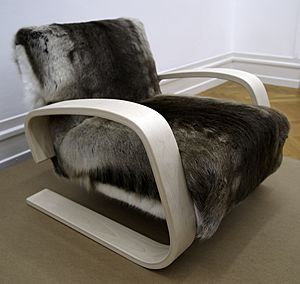
Alvar Aalto was famous for his architecture, but his furniture designs are also very popular. He learned from other famous designers. In the late 1920s and 1930s, he worked closely with Aino Aalto on furniture. They designed many pieces for the Paimio Sanatorium.
Their experiments with bent plywood chairs were very important. This included the Paimio chair, designed for patients with tuberculosis, and the Model 60 stacking stool. In 1935, the Aaltos, along with others, founded the Artek company. This company sold Aalto's products and imported designs from other artists. Aalto was the first furniture designer to use the cantilever principle (where a part sticks out without support) in wooden chairs.
Aalto's 'High Stool' and 'Stool E60' are still used today. For example, Apple Stores around the world use them for customer seating. Aalto also helped bring modern art to Finland.
Awards and Recognition
Alvar Aalto received many awards for his work. These included:
- The Prince Eugen Medal in 1954.
- The Royal Gold Medal for Architecture from the Royal Institute of British Architects in 1957.
- The Gold Medal from the American Institute of Architects in 1963.
He was also a member of the Academy of Finland and its president from 1963 to 1968. In 1960, he received an honorary doctorate from the Norwegian University of Science and Technology.
Alvar Aalto's Works
Aalto's career shows how architectural styles changed. He moved from Nordic Classicism to modern styles. He designed everything from large city plans to small items like furniture and glassware. It is thought that Aalto designed over 500 buildings, and about 300 of them were built. Most of his buildings are in Finland, but some are in France, Germany, Italy, and the USA.
Aalto's work with wood was very special. He found new ways to cut and use beech wood and plywood. He used plywood as a strong part of a building and also for its beauty. For example, in his Vyborg Library, the ceiling has amazing wavy shapes made of pine wood. He also created very wide roofs without needing extra support. In his stairway at Villa Mairea, he made columns that look like a natural forest.
Aalto said his paintings were not just art, but part of his architectural design process. Many of his small wood sculptures led to larger architectural ideas. He even got patents for new ways to make laminated bent-plywood furniture. His experimental style was influenced by the Bauhaus design school. Aalto's furniture was shown in London in 1935 and was highly praised.
Aalto also influenced Finnish art by introducing the works of his friends Alexander Milne Calder and Fernand Léger.
Important Buildings by Alvar Aalto
- 1927–1935: Municipal library, Viipuri, Finland (now Vyborg, Russia)
- 1928–1933: Paimio Sanatorium, Tuberculosis sanatorium, Paimio, Finland
- 1937–1939: Villa Mairea, Noormarkku, Finland
- 1939: Finnish Pavilion, at the 1939 New York World's Fair
- 1947–1948: Baker House, Massachusetts Institute of Technology, Cambridge, Massachusetts, U.S.
- 1949–1966: Helsinki University of Technology, Espoo, Finland
- 1949–1952: Säynätsalo Town Hall, Säynätsalo (now part of Jyväskylä), Finland
- 1952–1958: House of Culture, Helsinki, Finland
- 1953: The Experimental House, Muuratsalo, Finland
- 1957–1967: City center (library, theatre, City Hall, Lakeuden Risti Church and administrative buildings), Seinäjoki, Finland
- 1958–1972: KUNSTEN Museum of Modern Art Aalborg, Aalborg, Denmark
- 1959–1962: Community Centre, Wolfsburg, Germany
- 1962–1971: Finlandia Hall, Helsinki, Finland
- 1965–1968: Nordic House, Reykjavík, Iceland
- 1966: Church of the Assumption of Mary, Riola di Vergato, Italy (built 1975–1978)
- 1973: Alvar Aalto Museum, Jyväskylä, Finland
- 1959–1988: Essen opera house, Essen, Germany
Furniture and Glassware Designs
- Chairs
- 1932: Paimio Chair
- 1933: Model 60 stacking stool
- 1933: Four-legged Stool E60
- Lamps
- 1954: Floor lamp A805
- 1959: Floor lamp A810
- Vases
- 1936: Aalto Vase
Famous Quotes by Alvar Aalto
- "God created paper for the purpose of drawing architecture on it. Everything else is at least for me an abuse of paper."
- "We should work for simple, good, undecorated things...things which are in harmony with the human being and organically suited to the little man in the street."
- "It’s not an art to take and copy everything from tradition or past. It’s necessary to take the material and energy from nature and respond with the work of art, bringing your own psychical energy into it."
Remembering Alvar Aalto
Alvar Aalto is remembered in many ways:
- The Alvar Aalto Medal is a very important award in architecture, named after him.
- His picture was on the 50 markka banknote in Finland before the Euro.
- In 1998, for 100 years since his birth, Finland celebrated with books, exhibitions, and even special Aalto Wine and cupcakes!
- In 1976, a Finnish postage stamp was made to honor him.
- A square in Milan, Italy, is named Piazza Alvar Aalto.
- Aalto University in Finland, formed in 2010, is named after him.
- Streets named Alvar Aalto Street can be found in five Finnish cities.
- In 2017, the Alvar Aalto Museum started "Alvar Aalto Cities." This is a network of cities around the world that have buildings designed by Aalto. The goal is to share his work with more people.
See Also
 In Spanish: Alvar Aalto para niños
In Spanish: Alvar Aalto para niños
- Architecture of Finland
- Aino Aalto
- Elissa Aalto


